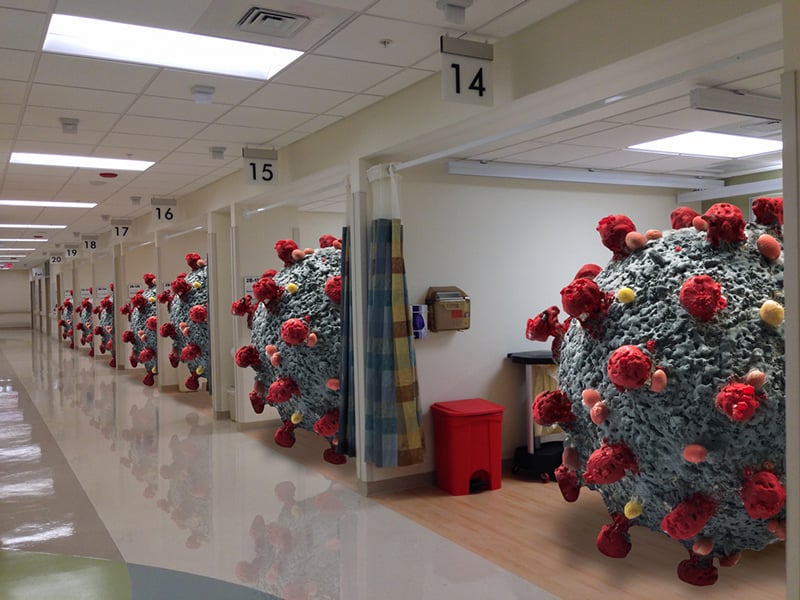MISC: A Pediatric Quandary for the COVID Era
Kevin Bennett, MSIV - Florida International University's Herbert Wertheim College of Medicine
EMRA MSC SE2 Regional Representative, 2021-2022
A new threat has entered the differential of every medical student presenting a pediatric patient who seems to acutely have everything wrong with them. Gone are the days of the great Mycoplasma mimic, late is the hour of the Lupus scapegoat, and Kawasaki, once a laudable suggestion, is ready for the chopping block as your astute attendings drop the latest NEJM on your assessment. In a world where many people are post-COVID, we must now be on the look-out for post-COVID syndromes, and nothing will perk up a sleepy pediatric ED like a possible case of Multisystem Inflammatory Syndrome in Children (MISC).
MISC first started popping into triage around April of 2020 when EDs were tripling previously quadrupled efforts to end “this COVID thing” before it got really out of hand. Physicians were reporting a syndrome that looked like Kawasaki, gestalt-ed like toxic-shock, yet was something new altogether. Children were presenting with persistent headaches, rash, myalgias, GI complaints, and a high susceptibility for shock all in the presence of an active or recent infection with SARS-CoV-2 [1]. Since those initial presentations, MISC has remained a rare complication of COVID in patients under 21 years old with several reviews suggesting an incidence < 1% in pediatric COVID cases, average age of 9.3 years, and disproportionately high numbers of Hispanic and Black patients affected. However, the severity of MISC is apparent with a PICU admission rate of 68%, mechanical ventilation use in 15%, and shock affecting 26% of patients [2,3,4]. With proper treatment the mortality rate is suppressed to only 1.9% [4]; however, as COVID remains a top priority and new vaccine-evading variants threaten an extended endemic tenure, we will need to understand the clinical picture of this syndrome to better serve our patients and complete our differentials.
To properly identify MISC, one must carefully balance clinical suspicion with laboratory markers and ultimately end in a diagnosis of exclusion. The first crucial requirements in your history to begin meeting criteria for MISC are a fever for >2 days and active or recent infection with SARS-CoV-2 shown by PCR, antigen, or known exposure to a COVID-19 infected individual within the past 4 weeks [5]. Getting the COVID history can make or break you with this diagnosis as you could easily follow a pediatric fever into oblivion and many syndromes present just like MISC. For the foreseeable future, COVID is going to be a huge red flag in all areas of medicine, and since the ED is at the front lines of all areas of medicine...GET THAT COVID HISTORY! Next, we want to look for involvement of multiple organ-systems that is clinically severe and isn’t explained by another obvious etiology [5]. This will be teased out through a combination of history, physical, and labs/imaging, but commonly associated symptoms indicating multiple organ-system involvement include abdominal pain, shortness of breath, rash, conjunctivitis, and headache [1]. Clinical findings will include shock, essentially all criteria for Kawasaki (Fever lasting >4 days + conjunctival injection, oral lesions/inflammation, cervical lymphadenopathy, extremity erythema or desquamation, and polymorphous rash), and acute respiratory failure. Laboratory findings may just look like everything is wrong all at once with neutrophilia, thrombocytopenia, markedly elevated cardiac markers, and hypoalbuminemia [6,7], but we want to hone in on indisputable laboratory evidence of systemic inflammation [5]. Essentially, if you’ve thrown the kitchen sink, an ET tube, and an echo for good measure at a patient with MISC, then you should have a pretty compelling case for the PICU.
So, you read this article, you’re on your peds or EM rotation, and you step out of a room thinking “Wow, this patient is super ill-appearing, febrile, and screaming MISC, but how do I effectively present this weird, crazy syndrome without getting in over my head?” Well first you can obviously mention the patient’s age, duration of fever, and verified COVID history to begin the criteria for diagnosis of MISC, but remember to mention key factors like ethnicity (African-American and Hispanic are at higher risk) and other common comorbidities for poor prognosis with MISC (i.e. asthma and obesity [8]). Briefly mention the other concerning symptoms and physical findings that clue you into multiple organ-system involvement, and go the extra mile to bring your attending up-to-speed with the current vitals, laboratory evidence of inflammation, and imaging so they can begin to stratify the urgency and aggressiveness of treatment and clench those diagnostic criteria. A tight differential on MISC will probably stay in the realm of Kawasaki, toxic-shock syndrome, sepsis, some autoimmune disease, or maybe a multi-system viral infection depending on the exact presentation, but remember that you may also be looking at an active COVID infection so don’t get lazy with your PPE!
The work-up and treatment are highly dependent on the severity of the patient’s illness, but for this example let’s assume your patient is still under investigation and not being actively resuscitated in the ambulance. Your primary arsenal of tests when considering MISC should be a CBC, CMP, CRP, ESR, and COVID test [9]. Other tests such as echos, EKGs, UAs, blood cultures, CXRs, and cardiac/coag labs could be indicated right off the bat, but should at the very least be in your back pocket [9]. Now, as you round third and prepare to slide headfirst into your treatment recommendation, remember a few very important considerations. You want to give every MISC patient IVIG, and if there is evidence of cardiac involvement or shock, then you will want to also include glucocorticoids. Since these patients have a tendency to go into shock, you will also want to prep the patient for the resuscitation in your plan (i.e. bilateral IV access, continuous vitals, supplemental oxygen, etc) [9]. You also need to remember that while you were celebrating a successfully diagnosed MISC case, you may have also unknowingly diagnosed Kawasaki and should throw aspirin in at the end of your plan to cover your bases and keep your patient safe [10]. Lastly, this patient will likely need input from infectious disease, cardiology, and certainly admission to the hospital or ICU, so be sure to ask your attending for any additional standard work-up for admission that you can start cooking in the ED.
In conclusion: don’t stop reading about COVID. This “thing” is not going away soon and syndromes like MISC may only be the first of its echoes. I’m reminded of the epidemic of encephalitis lethargica (aka von Economo’s encephalitis) that spread across the world 100 years ago, killed over 500,000 people, and affected many more with a syndrome characterized by lethargy and CNS dysfunction [11]. It was an unwelcome visitor during WWI and has been linked to Spanish Flu or some other infectious etiology of the time; however, its full impact would not be unveiled for decades as idiopathic parkinsonism with marked catatonia that began to appear from no apparent etiology was linked back to mild cases of encephalitis lethargica many years earlier [12]. With any luck, COVID will come and go as a pandemic that terrorized emergency departments, overflowed ICUs, and caused a bump in residency applicants for Infectious Disease, but considering the severity of acute COVID and peculiarity of MISC it behooves a betting doctor to keep post-COVID possibilities on the mind for years to come.
Many thanks to John Mark Saunders MD, Assistant Professor of Pediatrics at Herbert Wertheim College of Medicine, for reviewing this article.
References:
- Feldstein LR, Rose EB, Horwitz SM, et al. Multisystem Inflammatory Syndrome in U.S. Children and Adolescents. N Engl J Med. 2020;383(4):334-346.
- Feldstein LR, Tenforde MW, Friedman KG, et al. Characteristics and Outcomes of US Children and Adolescents With Multisystem Inflammatory Syndrome in Children (MIS-C) Compared With Severe Acute COVID-19. JAMA. 2021;325(11):1074-1087.
- Dufort EM, Koumans EH, Chow EJ, et al. Multisystem Inflammatory Syndrome in Children in New York State. N Engl J Med. 2020;383(4):347-358.
- Kaushik A, Gupta S, Sood M, Sharma S, Verma S. A Systematic Review of Multisystem Inflammatory Syndrome in Children Associated With SARS-CoV-2 Infection. Pediatr Infect Dis J. 2020;39(11):e340-e346.
- CDC Health Alert Network. Multisystem inflammatory syndrome in children (MIS-C) associated with coronavirus disease 2019 (COVID-19). Published May 14, 2020. Accessed October 10, 2021. https://emergency.cdc.gov/han/2020/han00432.asp
- Davies P, Evans C, Kanthimathinathan HK, et al. Intensive care admissions of children with paediatric inflammatory multisystem syndrome temporally associated with SARS-CoV-2 (PIMS-TS) in the UK: a multicentre observational study [published correction appears in Lancet Child Adolesc Health. 2020 Jul 17;:]. Lancet Child Adolesc Health.
- Belhadjer Z, Méot M, Bajolle F, et al. Acute Heart Failure in Multisystem Inflammatory Syndrome in Children in the Context of Global SARS-CoV-2 Pandemic. Circulation. 2020;142(5):429-436.
- Bixler D, Miller AD, Mattison CP, et al. SARS-CoV-2-Associated Deaths Among Persons Aged <21 Years - United States, February 12-July 31, 2020. MMWR Morb Mortal Wkly Rep. 2020;69(37):1324-1329.
- Chiotos K, Corwin D, Sartori L, et al. Emergency Department, ICU and Inpatient Clinical Pathway for Evaluation of Possible Multisystem Inflammatory Syndrome (MIS-C). Children’s Hospital of Philadelphia. Last revised July 2021. Accessed October 10, 2021. https://www.chop.edu/clinical-pathway/multisystem-inflammatory-syndrome-mis-c-clinical-pathway
- Kusakawa S, Tatara K. Efficacies and risks of aspirin in the treatment of the Kawasaki disease. Prog Clin Biol Res. 1987;250:401-413.
Ravenholt RT, Foege WH. 1918 influenza, encephalitis lethargica, parkinsonism. Lancet. 1982;2(8303):860-864. - McCall S, Vilensky JA, Gilman S, Taubenberger JK. The relationship between encephalitis lethargica and influenza: a critical analysis. J Neurovirol. 2008;14(3):177-185.
Related Content

Dec 09, 2020
8 Tips to Finding a Job During a Global Pandemic
A pandemic has introduced the house of medicine to unprecedented numbers of hiring freezes, suspended bonuses, and scaled-back continuing medical education funds and stipends. Add to that looming cuts by CMS. What does a job search look like in these conditions?

May 29, 2025
The Evolution of the Physician's Mask
A safety precaution as simple as a mask has become the symbol of the struggle physicians face during – and after – a public health crisis. Whether it was the Black Death or COVID-19, the physician’s mask has been a catalyst for patients’ emotions. But it can also symbolize the chance for doctors to be a trusted source of information.





